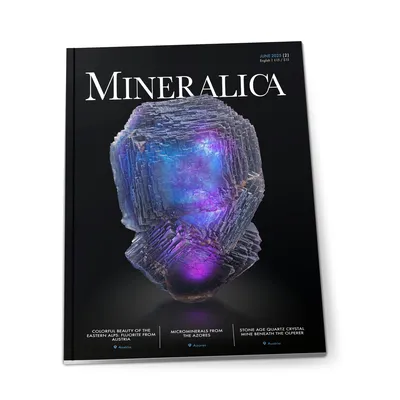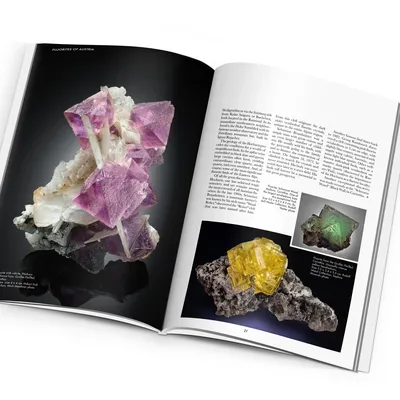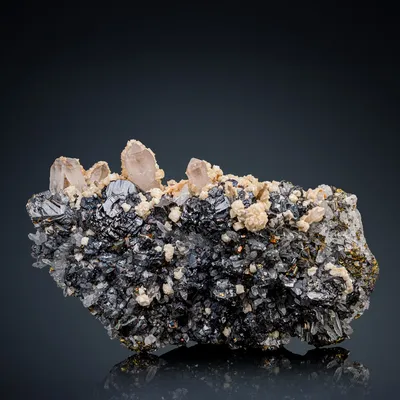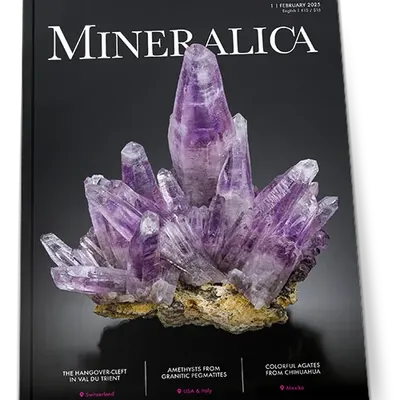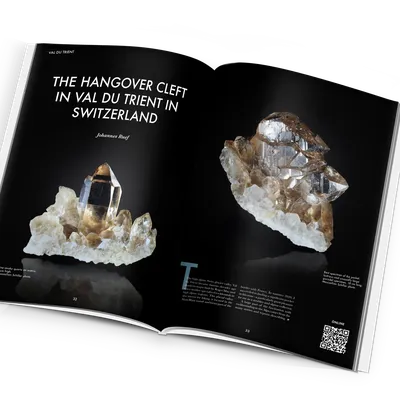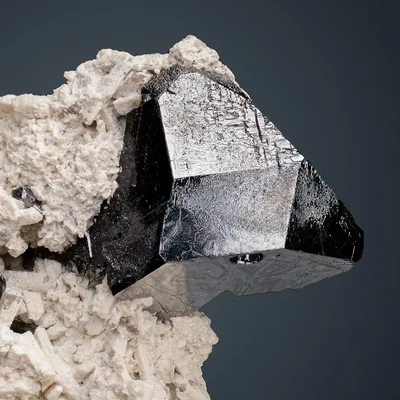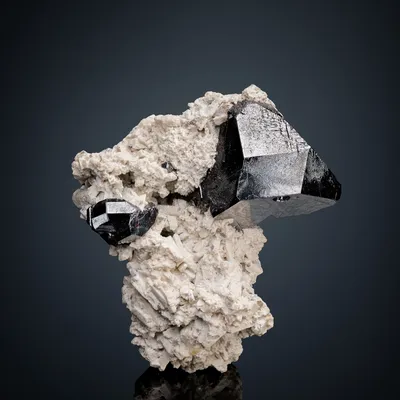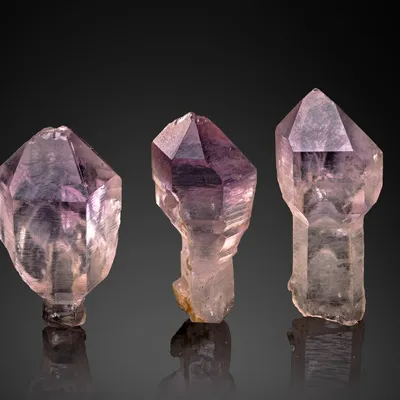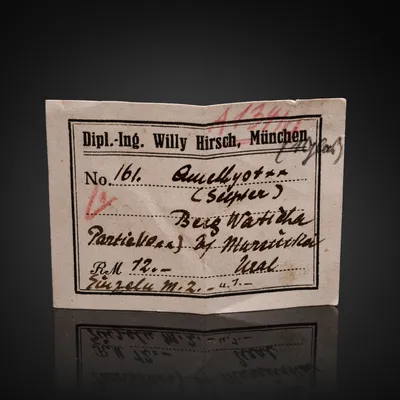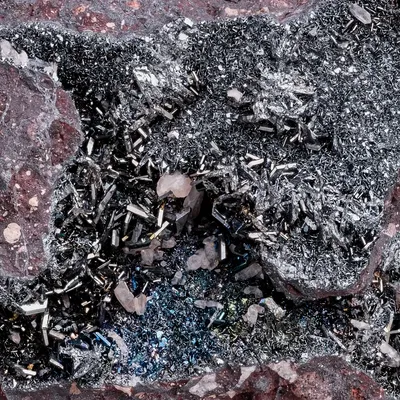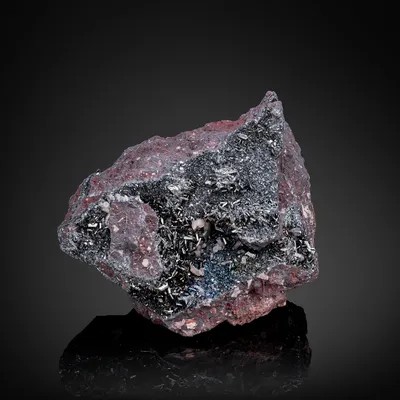Pala District: The Pegmatites of the Chief Mountain and Their Minerals
The Pala District in California is home to rich pegmatite deposits that have produced some of the most beautiful gemstones in North America. Particularly noteworthy are the spectacular kunzite crystals and the famous blue-cap tourmalines, which are still extracted in active mines today.

Table of Contents
- Intro
- The History of the Chief Mountain mines
- The Pala Chief Mine
- The Hazel W / Elizabeth R Property
- The Oceanview Mine
- The Minerals of the Pala District Mines
- Amblygonite & Montebrasite
- Beryl
- Bavenite
- Bertrandite
- Bismite
- Bismuth
- Bismuthinite
- Bismutite
- Clay Minerals
- Clinobisvanite
- Columbite Group
- Cookeite
- Albite
- Microcline-Orthoclase
- Fluorapatite
- Mica Group
- Biotite
- Muskovite
- Polylithionite-Trilithionite Series
- „Zinnwaldite“
- Molybdenite
- Monazite
- Phosphate Nodules
- Phosphosiderite
- Pollucite
- Pucherite
- Pyrite
- Quartz
- Spessartine
- Spodumene
- Topaz
- Turmalin Group
- Unknowns
- Zeolithe Group
- Acknowledgements
Intro
The pegmatite deposits of the Pala district in San Diego County in California have produced mineral specimens since the late 19th century. These deposits consist of granitic pegmatite dikes hosted by the gabbroic rocks of four mountains that make up the district: Queen, Hiriart, as well as Little Chief and Chief Mountains (Jahns and Wright 1951). The period 1900 to 1922 represents perhaps the largest mining activity the district has experienced, and production from the post World War II years until the 1990s was sporadic though several significant finds were made (e.g., Mauthner 2020, Fisher 2002 and references therein).
Renewed activity at the Elizabeth R, Oceanview, and Pala Chief mines, all on Chief Mountain since 2001 has produced another significant supply of mineral specimens for the market. Major and minor finds have uncovered many fine beryl (var. morganite and aquamarine), excellent quartz (var. citrine-smoky quartz and smoky quartz), various tourmaline species and color varieties, microcline, albite, and several interesting associated minerals (e.g., columbite group, apatite and other phosphate minerals, rare bismuth vanadates, and zeolites), including a couple of unknowns that may be new species.
The History of the Chief Mountain mines
The early history of the Pala District mines has already been well chronicled by others (e.g., Jahns and Wright 1951, Weber 1963, and Fisher 2002). Here are a few details on the major properties located on Chief Mountain.. Three claims – the Pala Chief, Ocean View, and Goddess – were recorded as part of the Pala Chief group around the turn of the twentieth century by Frank Salmons and Ed Fletcher. During the 1950s a patent was filed on these claims, but the Ocean View was withdrawn from the patent application. Jahns and Wright (1951) mention four named prospects: the Meadow, Poison Oak, Redwing (Redlands), and Jackpot Tunnel (Butterfly). They also mention a mine (the Ocean View) as being on the Ocean View property. The property was restaked in May 1973 by Joe Zeld and sold to Roland Reed in December 1973 (Roland Reed, pers. comm., 2008). Reed worked the Ocean View mine in 1974 but turned his attention to another property, the Hazel W, later that year (Reed, pers. comm., 2008). Reed patented the Ocean View property in December 1979, and in September 2000, he sold it to Jeff Swanger and Stephen Koonce, Jr. (Jessie Fisher 2002). Swanger is currently the sole owner of the Ocean View claim and operates as Oceanview Gem Mining, LLC.
The Pala Chief Mine
Frank A. Salmon, Bernardo Hiriart, Pedro Peiletch and John Giddens located and staked the Pala Chief gem deposits in May 1903. They developed the mine until about 1914, when commercial mining ceased due to a glut in the market for American gem material. The best known of the finds made during this early period was a large pocket called the "Bridal Chamber". Mining was only sporadic after 1914. Collector Bob Bartsch mined the Chief for several months in the mid 1960's, finding triphane and kunzite, and Pala International mined there in the early 1970's with minor finds. The mine passed into the hands of Bob Dawson in the 1980's, mined there until 2011, when he sold the claim to Jeff Swanger’s Oceanview Mines, LLC. While finds were not plentiful for Bob, he did pull some significant specimens out, including some spectacular matrix tourmaline pieces.
The Hazel W / Elizabeth R Property
The Hazel W prospect was among those controlled by the former Pala Chief Mining Company, of which Frank Salmons was the president (Weber 1963). Not much activity is recorded regarding it, but in 1972, Mike Myers and Charles Baker restaked the Hazel W. Reed bought it from them in April 1974 and renamed the property the Elizabeth R, after his daughter. His workings (the Elizabeth R mine), active since 1974, are on the border between the Elizabeth R and Ocean View properties. His early “upper” workings are on the Ocean View claim side and the later “lower” workings on the Elizabeth R claim side (Reed, pers. comm., 2008). Jeff Swanger purchased the claim and mine from Roland Reed in 2010 and has operated intermittently since alongside activity in the Oceanview and Pala Chief mines.
The Oceanview Mine
In late 2001, Swanger and his team – which at the time included Phil Osborn, his son, Brian, and Peter Renwick – started a new adit on a lower portion of the Ocean View pegmatite dike system and called it the Oceanview mine. The crew drilled and blasted their way through barren rock for nearly two years before they hit the first real pocket, which produced beryl, quartz, and columbite specimens. Around that time, the team was joined by Mark Baker and Steve Carter. Inspired by the success of this pocket, they continued mining (basically digging a tunnel designed for access) in search of more specimens. However, the new team labored for more than three years, tunneling more than 400 feet before seeing any real indicators to suggest that the minerals they were after might be nearby. Toward the end of summer 2007 and after 421 feet of tunneling, work was slowed down by permitting issues, and the miners decided to spend the power they had left on chasing minerals in some promising zones they had encountered along the way, rather than on more drift work. The partners chose what appeared to be the most attractive target and started drilling. Not far in, on 22 September, Steve Carter and Phil Osborn found balls of clay and a beryl specimen in the muck after a blast. They had uncovered the first part of what has now become known as the 49er Pocket. The name was a natural choice because 22 September 2007 happened to be Jeff Swanger’s forty-ninth birthday and because the miners saw the general connection of the spirit of California mining being synonymous with the great gold rush of 1849.
Hundreds of specimens, from good to very fine were recovered. They are distinctive examples of Pala district minerals (especially beryl), many of which would grace any collection of American gem minerals. Mauthner (2008) provides a more in-depth description of this find. After gleaning all that the 49er had to offer, miners went back up the haulage tunnel and stoped up-dip on the pegmatite dike at a few locations where they thought pockets might be encountered. Though several were indeed found, they held only smoky quartz, feldspar and minor schorl. While these provided some nice specimens and a bit of cutting rough, the holy grail of this location is lithium, or rather lithium-bearing gem minerals; thus far a frustratingly elusive quarry at the Oceanview. More frustrating still has been that only 40 feet away in the same dike, miners found beautiful kunzite crystals in the Elizabeth R mine during the summer of 2008; not to mention Roland Reed’s finds over the past 30 years of kunzite, colored tourmaline and morganite. The latter is not strictly speaking lithium-bearing but desirable, nonetheless. For months, the crew kept walking by, and occasionally picking at, a small zone that seemed to whisper, “dig here.” Directly opposite the 49er pocket stope in a roughly one square meter area in the footwall of the haulage drift, there was pink clay with very small, very pale-colored fragments of spodumene. Stoping downward is not such a good idea for several reasons, so the team decided to continue the turn-around at the end of the haulage drift, come back and down toward a point directly in line with the 49er stope. In November 2009, the first small specimens of kunzite made an appearance – a handful of pale to moderately colored etched crystals up to 2.5 cm. Then, on December 3, miners exposed the first major spodumene (kunzite) pocket of the Oceanview mine. It produced several kilograms of fine, gem-quality material including a single crystal of over 300 grams (Mauthner 2011). Excavation of the December 2009 pocket lasted only a short while, but in continuing the second level of the haulage tunnel, now dubbed “Carter’s Court,” signs of increasingly interesting mineralization turned up. Within the next few months in the spring of 2010, small pockets with minor amounts of spodumene, smoky quartz and dark tourmaline were encountered. Things really looked better when miners hit lepidolite masses reminiscent of those in the Stewart Lithia mine. Tourmaline unearthed during that period ranged from black schorl at first, then crystals with very deep purple with pale green tips, followed days later by a basketball-size pocket of green to bicolored green-blue pencils, and finally pink tourmaline crystals frozen in massive lepidolite made their appearance (Mauthner 2011). This area opened into what is now called the Big Kahuna pocket, named for the mine owner’s father, Jerry Swanger, who had passed away shortly before. Miners hauled out many kilograms of pink tourmaline specimens, some of which have a thin blue to green zone at the terminations; usually the basal but in some cases, both. The Big Kahuna pocket turned out to be more of a “zone” than a single pocket, having a large central pocket with dimensions of approximately three meters wide by two meters deep by three quarters of a meter high along with many smaller satellite pockets.

During November-December 2010, miners had extended the Carter Court level and driven yet another turn-around and started the third level, named Baker Boulevard. By late December 2010, miners hit a down-dip extension of the Big Kahuna zone. More, larger, and intensely colored tourmaline specimens with associated albite and spiky bunches of equally color-saturated lepidolite from the Big Kahuna II zone comprised a special display unveiled at the 2011 on show – the theme of which was "Californian Minerals." The Depth of color in the spodumene and lepidolite mica is unusually intense to say the least – likewise the zonation and color variety in the tourmaline crystals. After finally having finished the Big Kahuna II zone and having continued along the strike of the pegmatite on Baker Boulevard level, miners encountered country rock. There were no signs of the fault seen at the eastern limit of the main haulage tunnel. Exploration sideways revealed that this was in fact a large xenolith in a very wide part of the pegmatite dike. This “Xenolith Zone” also hosted pockets of fine gem material and specimens, particularly kunzite.
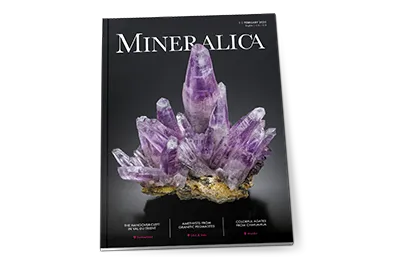
The new premium magazine for mineral collectors
4 issues per year – packed with fascinating finds, expert knowledge, and collector passion. The first bilingual magazine (German/English), including full online access.
Explore subscriptionAfter months of extending the Baker Boulevard level and having encountered the same fault that was at the main haulage tunnel turn-around to Carter Court level, it was decided to shift focus to the Pala Chief mine. Soon after, in December 2011, the team hit what wasn’t at first called the 2011 Triphane Pocket, but that is the name it became publicly known as. It produced about 500 kilograms of straw-colored, triphane variety of spodumene; the very little else it contained was a single beryl (pale aquamarine) crystal in two parts and a few pale kunzite specimens. A smaller, adjacent pocket surprised the miners with two large matrix morganite specimens that are perhaps the finest ever to emerge from this mine. Later in 2012, work began in the Oceanview mine again. The decline was continued at the south end of Baker Boulevard and dubbed Osborne Alley. Another level (4th) was driven under Baker Boulevard and called Swanger Street. It turned out to be an exercise in frustration as everything appeared to be going right; “signs” were everywhere. The largest lepidolite pod outside of the Stewart mine was there with kaolinized pseudomorphs after spodumene crystals up to a meter long by 30 cm wide. Large colorful tourmaline crystals in the pegmatite fell to sand when touched. It just seemed the dike had been “cooked” by late-stage fluids and everything had been altered. Further down Osborn Alley and south into the pegmatite (South Zone), which was getting thicker it seemed, led to several small pockets of greenish-blue capped red tourmaline, the odd morganite, more red elbaite slugs, quartz and the largest (to football sized) phosphate nodules (Mauthner 2015). Every now and then there has been something to tease the miners on, but nothing on the scale of the Big Kahuna zones has been found since.
The Minerals of the Pala District Mines
The pegmatite dikes of Chief Mountain, as with all the dikes in the Pala district, occur exterior with respect to a source pluton and can be considered of the LCT-type of pegmatite (Lithium-Cesium-Tantalum). Accordingly, they are host to minerals rich in these elements, such as Li-essential spodumene, Cs-bearing beryl and members of the columbite group. The complex pegmatites are also richly endowed with several tourmaline species, several members of the mica group and other, less-common accessory minerals. The major finds of tourmaline, spodumene and beryl in Chief Mountain have already been described above, under History; the comprehensive species list below glances again at some of these, mentions a few further finds, and notes species found in the historic literature as well. Most of the new information on minerals of the Oceanview, Elizabeth R and Pala Chief mines was gathered during the period 2007-2016, with some analyses done since then.
Amblygonite & Montebrasite
Massive pods of amblygonite and/or montebrasite are perhaps more common in the Oceanview pegmatite than one might guess: the white to bluish-white mineral resembles massive milky quartz or feldspar and is often overlooked. In the “Carter Court” workings of the first Big Kahuna pocket zone, a pod of amblygonite-montebrasite 30 to 40 cm across was drilled through and blasted away, and an occurrence of bluish amblygonite-montebrasite was found in the Elizabeth R (mid workings) in summer 2019. Jahns and Wright (1951) mention large, meter-scale masses in other pegmatite dikes of the district.
Beryl
Beryl, as morganite, aquamarine and color-zoned varieties, occurs as stout, commonly doubly terminated, hexagonal prisms with first order and in some cases second order bipyramidal modifications and basal pinacoid terminations. Morganite and bicolored beryl has been intermittently encountered in the Oceanview mine (Mauthner 2015), but even more so in Elizabeth R, which yielded some of the finest morganite specimens ever found in southern California during Roland Reed’s mining project (1974 – 2010) (Fisher 2002).
A small pre-2007 find was made in a pocket along the initial (main level) haulage tunnel of the Oceanview mine. The best piece was a palm-size, somewhat etched/battered, though transparent morganite. The best find of this species was undoubtedly in the 49er Pocket, where many specimens featured separated, intergrown or bicolor crystals of both morganite and aquamarine varieties have been found. One such specimen, now at the Fallbrook Gem and Mineral Museum, was appropriately nicknamed “Pinky and Blue Boy” after the famous Gainsborough paintings (Mauthner 2008).
Several beryl crystals from the 49er pocket contain naked eye-visible two-phase inclusions. Other inclusions found in beryl include quartz, manganese oxides, and tourmaline (schorl-elbaite series). In one crystal, pseudo-cubic inclusions thought to be native bismuth have been noted (Cal Graeber, personal communication). While the species has been found in the morganite variety of beryl, Schmitz et al. (2020) reported for the first time spodumene as sharp monoclinic inclusions in a pale blue aquamarine crystal from the Oceanview mine. Two large “museum-size” specimens featuring orange-rose morganite crystals to 6-7 cm across on cleavelandite were pulled out of a pocket adjacent to the December 2011 “Triphane Pocket” in the Pala Chief mine (Mauthner 2015).
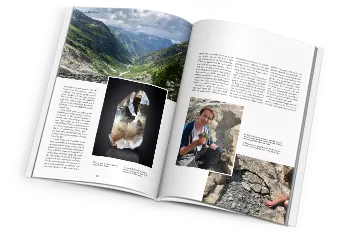
The must-have for everyone who collects minerals
Mineralica is your premium collector’s magazine – made exclusively for lovers of minerals and fossils. In print, bilingual, and with full access to the complete online library.
View issue previewBavenite
Small radiating clusters of white prisms intimately associated with beryl are reported by Jahns and Wright (1951) as very rarely occurring in pockets in the Pala Chief mine. Bavenite is interpreted to be an alteration product of the associated beryl.
Bertrandite
Bertrandite occurs very rarely in the Pala Chief mine, where it is also found as white to pale gray tabular crystals intimately associated with beryl (Jahns and Wright 1951). They describe one specimen from the original open pit that appeared to feature bertrandite as a pseudomorph after a tabular beryl crystal.
Bismite
Jahns and Wright (1951) note bismite as occurring as a white to pale gray earthy coating on quartz in the Pala Chief mine. The alteration rinds on the bismuth nodules found in the Elizabeth R and Oceanview mines may well contain bismite, but this species has not been positively identified.
Bismuth
Jahns and Wright (1951) note bismuth as occurring in the Pala Chief mine. Gray nodules of fine-grained native bismuth measuring 2 to 3 cm were found at various spots in the Elizabeth R mine. Bismuth blebs measuring under 1 cm associated with yellow clinobisvanite and undifferentiated grayish earthy Bi alteration products were found in the Big Kahuna zone in the Oceanview mine.
Bismuthinite
Fibrous gray bismuthinite occurs associated with bismutite in the Pala Chief mine (Jahns and Wright 1951). They also note its occurrence at the Margarita mine, which was on the west flank of Chief Mountain, below the Pala Chief. However, the Margarita mine is now part of the Pala Indian Reservation and is no longer accessible.
Bismutite
Grayish to pale yellow bismutite occurs as an altertation product of native bismuth and bismuthinite in the Pala Chief mine (Jahns and Wright 1951). The grayish alteration zone surrounding the native bismuth nodules found in the Elizabeth R mine are also assumed at least to contain bismutite, though the alteration products have only been visually identified.
Clay Minerals
Analysis of several “types” of commonly occurring and differentiable clay were analyzed. Fairly pure montmorillonite occurs as dark red, soapy feeling masses in or near pocket areas. A pale pink, much harder version of such waxy, irregular pods is a mixture of montmorillonite, kaolinite and very fine-grained muscovite. Montmorillonite also occurs as inclusions in quartz, producing a translucent white to pinkish rind on otherwise clear quartz. These were found in a couple of pockets in the Elizabeth R and Oceanview mines and are indistinguishable from the classic ones known from the White Queen mine on Hiriart Hill.
Kaolinite is an all-too-common alteration product of spodumene, but it forms earthy, white to pale pink pseudomorphs after bladed spodumene crystals. Underground, this material is soft enough to be dug with the fingers, but pseudomorphs which are carefully extracted and allowed to dry, then impregnated with a resin or other hardening substance, can be preserved for collections. The best of these pseudomorphs really exhibit a textbook bladed pyroxene habit. If the material underground feels smooth to the touch, it is a sign that the alteration to clay has pretty much been complete; if gritty, then the alteration is not complete. The ‘grit’ consists of very fine sand-size etched remnants of spodumene, which are jewel-like under the microscope. The sticky red-brown clay that fills many pockets is not related to the emplacement history of the pegmatite dikes but is the result of the weathering of surrounding rocks. This clay was not analyzed for its specific mineralogical make-up.
Clinobisvanite
Foord (1996) identified red-orange clinobisvanite crystals with cream-white to tan radiating hemispheres of eulytite associated with albite from the Elizabeth R mine. Earthy yellow crusts on feldspar and mica, proximal to small bismuth nodules, collected in the lower part of the first Big Kahuna zone of the Oceanview mine, have been analyzed as clinobisvanite.
Columbite Group
Tabular to bladed crystals up to 2 cm of a member of the columbite group were found in pockets along the first haulage way tunnel in the Oceanview mine, before the 49er pocket was hit. Friable columbite crystals to several centimeters, some altered with encrustations of an earthy yellow mineral were encountered in 2010-2011 in the Big Kahuna II zone on Baker Boulevard level. One of these specimens was analyzed to be Columbite-(Mn) (Falster, personal communication 2021). A few matrix specimens representing this group of minerals came from a Swanger Street level pocket. One consists of a 3 cm wide crystal embedded in a 1.3 cm thick cleavelandite layer that had encrusted a schorl crystal. It is interesting that any part of the crystal that might have existed above the cleavelandite layer is gone. The remainder, held in place by the feldspar, is fragmented and cemented by an unknown earthy yellow mineral, and a black unknown mineral. The outside surface is coated in seemingly random tabular crystals resembling allanite. The specimen requires further study.
Cookeite
Cookeite is found in all the mines as buff to pale pink colored waxy coatings on pocket minerals, or as such colored pods, some containing gem crystals.
Albite
Albite occurs commonly in the cleavelandite habit of bladed crystals, with mounded aggregates of these crystals often providing “matrix” for crystals of quartz, microcline, tourmaline and beryl. Aplite seams in the pegmatite largely consist of finer grained albite, especially as part of the “line rock” in the footwall portions of most pegmatite dikes.
Microcline-Orthoclase
Most of the K-feldspar found in the pegmatite dikes is microcline. The graphic granite portions of the dikes consist of perthitic microcline and quartz (Jahns and Wright 1951). The coarsely perthitic, typically blocky crystals from a few centimeters to more than 30 cm found in the pockets are dominantly orthoclase with subordinate microcline. Many of these crystals exhibit moderately to highly etched faces, some to the point of being “boxworks” of albite lamellae. Some fine examples with Baveno twinning have been collected. The glassy overgrowth on some pocket K-feldspar is non-perthitic microcline (see Jahns and Wright 1951).
Fluorapatite
Fluorapatite, as druses of millimeter-size blue crystals, was found lining a fracture and spalled fragments in pockets in the Xenolith Zone on Baker Boulevard level.
For the heterosite-purpurite series, hureaulite and lithiophilite see phosphate nodules.
Mica Group
It should be noted that the identity of most of the micas at the Oceanview, Elizabeth R and Pala Chief mines is mostly based on visual (i.e. color) differences and by comparison to analyzed micas found in other San Diego County pegmatite deposits (e.g. Stern et al, 1986).
Biotite
Dark brown to black mica occurs along the contact with the host gabbro in many parts of the pegmatite dikes on Chief Mountain.
Muskovite
An exception to the color “rule” from the Oceanview mine are color zoned “books” of transparent, nearly colorless muscovite crystals with purple rims; the rims have been found to be lithium-rich muscovite although the purple color is due to manganese and not to lithium (Mills, pers. comm., 2011). Purple-rimmed muscovite crystals are not an uncommon occurrence in other pegmatite mines in San Diego County.
The 49er Pocket had some specimens with almost greenish books of muscovite on them, but the best muscovite specimens from these mines, featuring star-shaped twins, were collected in a small pocket in the pre-Big Kahuna area on Carter Court level especially in the upper parts of the pocket (Mauthner 2008).
Polylithionite-Trilithionite Series
Small masses of lepidolite were occasionally encountered in both the upper and lower workings of the Elizabeth R mine. In the Oceanview mine, the first “lepidolite” masses showed up in the early Big Kahuna zone. The darkest material was found on Baker Boulevard in the Big Kahuna II and Xenolith Zones. The largest mass, several meters in diameter, was on Swanger Street. It contained an altered spodumene (i.e. mostly clay) over one meter in length and about 30 centimeters wide. Just a few million years to late… Crystal aggregates of dark purple lepidolite, associated with albite and elbaite were found in the Big Kahuna II main pocket; a few more in pockets further along Baker Boulevard (Mauthner 2015).
„Zinnwaldite“
Jahns & Wright (1951) note the “very rare” occurrence of dark gray to deep reddish brown stubby prisms to 6-7 millimeters in some pegmatite pockets on Chief Mountain, but do not mention which. The crystals have a bronzy luster like phlogopite and are associated with quartz, albite (cleavelandite) and beryl. No zinnwaldite has been identified in the Oceanview, Elizabeth R or Pala Chief mines since 2001.
Molybdenite
Jahns and Wright (1951) describe molybdenite as flakes in quartz from the Pala Chief mine, but recent activity has not encountered any.
Monazite
Monazite is reported as “widespread but not at all abundant in the pegmatites” (Jahns and Wright 1951, p. 41) The mostly cinnamon-brown, small, equidimensional grains and tabular crystals usually occur in the albitite “line rock” as well as other albite-rich units (e.g., massive cleavelandite).
Phosphate Nodules
Nodules of several centimeters to pods of tens of centimeters across, which are mixtures of relict primary lithiophilite with several of its alteration products, have been found in many places in the Oceanview mine; the secondary phosphate species in question include hureaulite, “sicklerite”, “ferrisicklerite” and jahnsite. These pods are similar to those described by Shigley and Brown (1985) from the Stewart mine. Similar nodules in which the primary phosphate is triphylite have also been found. Schaller (1912) described a new red phosphate palaite, but this is a color variety of hureaulite. In the same paper, he also described sicklerite as a new phosphate mineral, however, it and its iron dominant counterpart, ferrisicklerite, have recently been discredited as merely being intermediate compositions of the weathering process of lithiophilite-triphylite to heterosite-purpurite (Lyalina, et. al., 2023). Salmonsite, found in the historic literature, is thought to be a mixture of hureaulite and jahnsite and has also been discredited (Moore and Ito 1978).
Phosphosiderite
Sub-millimeter spherical crystal aggregates of purple phosphosiderite were discovered in cavities in phosphate nodules on the 2nd level of the Pala Chief mine. This material has only been visually identified and may be the phosphosiderite dimorph, strengite (see Jahns and Wright 1951).
Pollucite
Pabst (1938) reports pollucite from the Pala and Mesa Grande Districts, but provides no further details.
Pucherite
Pucherite was first described from the Pala Chief mine by Schaller (1911). Drab olive-colored druses of pucherite were found coating tourmaline crystals and tourmaline/lepidolite masses in the Big Kahuna II zone; the largest specimen is a 15 cm-wide plate with considerable coverage of pucherite on both sides. Some of the coated tourmaline crystals were gemmy, deep red colored and of course, the temptation to remove the pucherite was great on the part of most of the miners. Several such crystals were nonetheless “rescued” to remain as pucherite specimens on tourmaline “matrix.”
Pyrite
Pyrite is uncommonly found throughout as cubic crystals usually less than 3-4 millimeters on edge. Most pyrite that was encountered in the Oceanview mine was weathered to some degree.
Quartz
Quartz is common in all the pockets in all these three mines on Chief Mountain. The translucent to transparent crystals range from almost colorless to an intermediate “smoky citrine” hue (dark yellowish brown); even crystals exceeding 30 cm are commonly highly lustrous and transparent. Many of the quartz crystals contain white acicular inclusions of an unknown mineral, at and near the terminal faces. Almost purely black smoky quartz was found as lustrous crystals in a small pocket in the pre-Big Kahuna area of “Carter Court” in the Oceanview mine. The Elizabeth R mine has yielded quartz crystals with montmorillonite inclusions—without documentation these are impossible to distinguish from specimens found in the 1960s in the White Queen mine on Hiriart Mountain. Some dark smoky citrine was also encountered on Baker Boulevard; many of these crystals had patches of a yellow earthy mineral that, upon initial investigation, may be a new uranium carbonate (Mills, pers. comm., 2011.) All three mines produce smoky citrine of a bewildering array of distorted, doubly terminated ‘floater’ crystal habits (e.g. spearhead shaped, pseudocubic, weirdly elongated in some direction). Most are translucent rather than transparent (like most of the pocket quartz) and have smooth, lustrous faces on one side and frosted and/or coated faces on the other.
Spessartine
Although garnet is a significant mineral component of the pegmatite dikes on Chief Mountain, most of it occurs as small grains in the basal “line rock” layers. Jahns and Wright (1951) state that these are largely iron-bearing spessartine. Larger crystals to 2.5-3 centimeters are much rarer but have been found in the interior zones of the dikes in the Oceanview, Elizabeth R and Pala Chief mines, but these are generally highly fractured and completely enclosed by pegmatite (i.e. not free-standing pocket specimens).
Spodumene
As stated in numerous places above (under History), kunzite spodumene of world-class quality has been found on several occasions in the three Chief Mountain mines. In July 2008, in Elizabeth R—before Swanger took over that mine – Roland Reed and Wayne Potterton took out a small lot of very fine kunzite crystals and did not realize that they had hit a pocket until they came on the kunzite crystals while screening the muck. The first big find at the Oceanview occurred on the 3rd of December, 2009 on Carter Court level. Within the next year and a bit, hundreds of kilograms of kunzite were extracted from the two Big Kahuna zones, one on the second (Carter Court) level, the other down-dip on the third (Baker Boulevard) level. Most of the smaller fragments are colorless to pale green, but the larger, strongly pleochroic crystals are green when viewed down the a axis and deep bluish to purple when viewed down c; some are pink to purple down a and deep purple down c. The best kunzite of all was found on Baker Boulevard level, in the Big Kahuna II and Xenolith zones.
It should be noted that the color of the green and the deep purple kunzite (as seen along a) can change to pink upon exposure to ultraviolet radiation (including some LED lights), but the intensity is roughly the same. A dark green original will result in a fairly dark pink; a pale green will go to pale pink. Experiments in which several pieces were left in the sun for several years did not fade to colorless like the kunzite from other locations such as Afghanistan or Brazil might.
The Triphane pocket of December 2011 in the Pala Chief mine yielded almost half a ton of spodumene, most of it gemmy straw-yellow; a very few pieces were pale lilac colored kunzite. The crystals are highly etched, with markings and pits on every surface that are much more intricate and unusual than those on most of the kunzite from the Big Kahuna zones in the Oceanview mine. About 15 specimens are sharply formed, with well-developed terminal faces and typically striated prism faces. This triphane is practically colorless under LED light while under daylight or incandescent light it is straw-yellow, and under CFL bulbs it varies from lemon-yellow to greenish yellow.
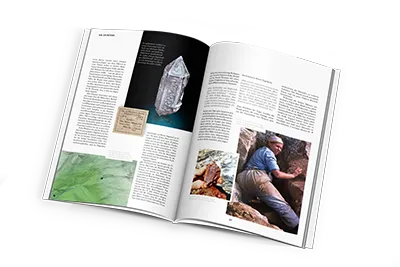
Discover more fascinating stories like this?
Mineralica brings you the most fascinating finds, places, and people from the world of mineral collectors – in print and online. A must-have for every collector.
Subscribe now and never miss an issueTopaz
Topaz is noted as very rare on Chief Mountain by Jahns and Wright (1951), as it is in the whole district. None has been found in the Elizabeth R, Oceanview or Pala Chief mines in these last decades of renewed activity.
Turmalin Group
Several tourmaline-group species occur as good to superb specimens in the Chief Mountain mines. Schorl was found in the 49er pocket as black, striated, trigonal-prismatic crystals, some partially coated by cleavelandite albite and/or by small, colorless quartz crystals.
Color-zoned tourmaline crystals from the 49er pocket have black cores and dark purple outer zones. Some loose, flattened crystals less than 2 cm long are dark purple throughout and wholly transparent in strong light: this purple tourmaline has been analyzed as foitite. Some pre-Big Kahuna pockets produced dark green tourmaline crystals which proved to be schorl-elbaite, as well as more of the dark purple foitite crystals. Pink with blue-green cap crystals from the Big Kahuna Zone occurred up to several centimeters in length and resemble miniature versions of the famous “blue cap” crystals found in the Tourmaline Queen mine on neighboring Queen Mountain. A few handfuls of superb gem-quality pink and green bicolored tourmaline were also recovered, the longest segment was about 4 cm long, as were a few large schorl-elbaite crystals to 15 cm long. The largest of these was extracted in three pieces (from different parts of the pocket more than a meter apart!) but, when repaired, ended up being about 15 cm in length.
Big Kahuna II produced excellent specimens with elbaite-schorl crystals which are pink to purple to cranberry-red, associated with intensely purple lepidolite, albite and smoky quartz. Other Big Kahuna II crystals look grayish purple in normal light but when backlit are seen to have bands of five or six different colors. In March-April of 2014, several slugs of deep pink tourmaline were found by fee diggers on the pile. The crew must have blasted through a pocket. Each blast round removes about 10 or more cubic meters of rock, so it is possible to take out a pocket and not know it…that is what makes the public dig so exciting. The material came from one of the south headings of the lower part of Osborn Alley and the mining team concentrated to find the source pocket, or at least more like it. In early May, one pocket containing several miniature- to fist-sized cabinet pieces of outwardly aesthetically challenged tourmaline crystals, but with incredibly deep red body color. Several specimens were marketed as the species luinaite-(OH) which was found as blue felted masses in the Elizabeth R and Oceanview mines: one of the Oceanview specimens shows a spherical aggregate of pale blue luinaite-(OH) perched on the terminal section of a broken schorl crystal. However, luinaite-(OH) has recently been discredited (Bosi, et al. 2022) and the exact species of this material is not known. Finally, in July 2019 the miners hit a pocket of good “bluecap” tourmaline crystals in a zone roughly in line—up-dip from—the 49er pocket.

The new premium magazine for mineral collectors
4 issues per year – packed with fascinating finds, expert knowledge, and collector passion. The first bilingual magazine (German/English), including full online access.
Explore subscriptionUnknowns
Several unknowns were collected at the Oceanview mine.
- Unknown OV-01: initial investigation of a yellow earthy encrustation on smoky quartz from Baker Boulevard has indicated that this may be a new uranium carbonate mineral but analytical methods available were insufficient to fully characterize the material (Mills, pers. comm., 2011).
- Unknown OV-03 is a grey earthy mineral enclosed by quartz, which exhibits a radiation damage halo around the inclusion.
- Unknown OV-05 consists of yellow earthy encrustation associated with columbite. Preliminary research suggests this is a mixture of uranophane, kaolinite and smectite (Falster, personal communication 2021).
- A green waxy to earthy coating (OV-14) was encountered in the south decline (Osborn Alley) that was assumed by the miners to be a Cu mineral, possibly malachite. Jahns and Wright (1951) list malachite as being present on Chief Mountain, but this study has not confirmed that. Similar material has been observed from the Katarina mine labeled pseudomalachite, and yet again from another mine on Hiriart Hill labeled chalcoalumite. Preliminary work shows a chemistry of Bi, Sb Al and Si, which does not match any known mineral species (Falster 2021).
- Columbite group mineral crystals overgrown by a network of red-brown stacked-tabular crystals (OV-15) were found on Swanger Street level in the Oceanview Mine.
Zeolithe Group
Wright and Jahns (1951) report the widespread but minor occurrence of three zeolite species: heulandite, stilbite and laumontite. Heulandite occurs as tabular brownish crystals to 2 millimeters in fractures and pockets. Stilbite occurs associated with the heulandite, on its own or with laumontite. In the last 20 years, stilbite was encountered in a few places in the Oceanview mine, and laumontite associated with Mn-oxides and cookeite, and with Bi-mineral nodules came out of the Elizabeth R mine.
Acknowledgements
I thank Jeff Swanger, Roland Reed, Steve Carter, Mark Baker, Phil Osborn, Daron Fisler and Bob Dawson for their assistance in preparing this article, sharing their knowledge, recollections, and company during nearly seven years of a lot of fun mining together! I thank Drs. Stu Mills and Al Falster for analytical work on some of the unknowns.






























